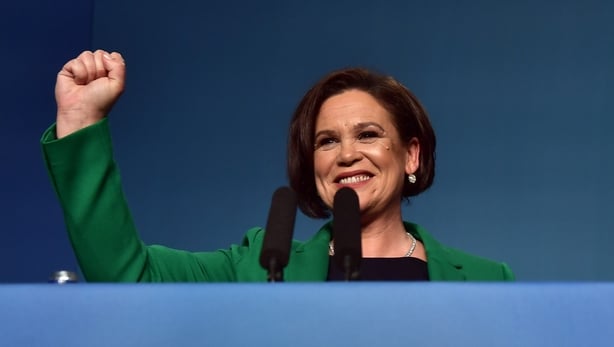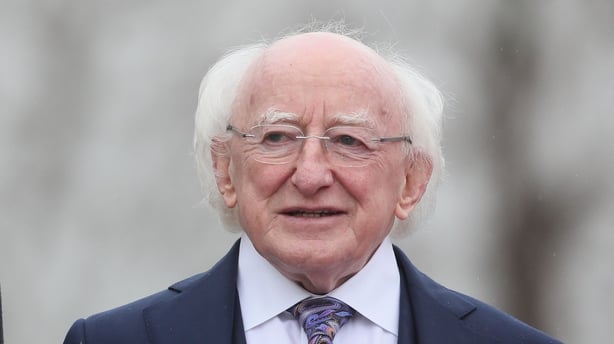Sinn Féin has finally confirmed that it will field a candidate for the presidency.
Party leader Mary Lou McDonald formally announced the move after months of espousing the need to have a contest.
Over the last fortnight though, she has ratcheted up her remarks. She told reporters "I don't think it's appropriate that the incumbent rolls into another term of office seamlessly. I think the election provides a platform for a very healthy debate about Ireland."
She prefaced her comments by saying they were her personal views and it was a matter for the party’s Ard Comhairle. Few political correspondents swallowed that.
For a leader to be overturned by her own party executive after staunchly stating her views so publicly would be a significant story in itself. And Sinn Féin is very disciplined and very strategic, especially when it comes to elections.

Many in political circles believe this is a win-win scenario for the party.
Sinn Féin will have a perfect platform to canvass every constituency with the added advantage that Fine Gael and Fianna Fáil are both sitting this one out in terms of running their own candidates.
The contest will be an opportunity for Sinn Féin to increase its vote and gain more mainstream support.
Looking back at the last presidential election in 2011, the party’s candidate Martin McGuinness got just under 14% of the first preference vote. Five years later, Sinn Féin secured a similar level of support at the general election. The party’s vote has plateaued.
But, it now has a new leader who is a strong media performer and has no links to the IRA.
The presidential contest is an opportunity to sell Mary Lou McDonald and the party as much as the candidate.
We need your consent to load this rte-player contentWe use rte-player to manage extra content that can set cookies on your device and collect data about your activity. Please review their details and accept them to load the content.Manage Preferences
No one will be surprised if the leader features on the posters. After all, Sinn Féin blatantly adopted this approach during the recent referendum on the Eighth Amendment – the only party to do so.
Mary Lou McDonald has stated that a presidential election is a good time to have a "national conversation" and proceeded to list a number of possible topics – Irish unity, Brexit, women’s issues etc. All are key priorities for the party.
It is no wonder that many TDs in the two bigger parties are concerned, very concerned.
One senior member of a campaign team in the previous presidential election believes it is a missed opportunity for Fine Gael and Fianna Fáil as a contest offers more than a dozen significant media opportunities including the television and radio debates.

There are other considerations – the costs. The spending limit for a presidential contest is €750,000.
A candidate who is elected or who gets more than a quarter of the quota will qualify to have their expenses reimbursed by the state up to €200,000.
Sinn Féin could run a cost-effective campaign and qualify to get the maximum amount back.
However, presidential campaigns are unpredictable – just three of the seven candidates qualified for a reimbursement in 2011.
On that occasion, Sinn Féin qualified to get their expenses, but Fine Gael lost out financially. This time round, both Fine Gael and Fianna Fáil are focusing on the next general election.
The two parties are mindful though of the possible exposure and electoral benefits for Sinn Féin.
While they are hugely supportive of President Higgins’ bid for a second term, Sinn Féin’s decision to run a candidate is likely to be a significant motivating factor in both parties getting out and actively supporting him at a local and national level.
The Taoiseach even suggested that Fine Gael may put up its own posters supporting him.
This would have to be agreed with his campaign team as it would have an impact on his expenses.
At present, Fianna Fáil has no immediate plans to put up posters but I’m sure they will be very visible in the media and on the ground.
The same applies to the Labour party which may ultimately contribute financially to his campaign.
After all, Micheal D. Higgins was the party’s candidate not only in the 2011 presidential contest, but also for more than four decades for the Dáil. As the incumbent in the upcoming presidential contest, he is running as an independent.

From a strategic and political perspective, it may also be in the interests of Sinn Féin’s political opponents if more candidates contest the presidential election. This would dilute the party’s presence and airtime.
There are also risks though, for Sinn Féin.
When Mary Lou McDonald initially spoke about the possibility of running a candidate – she referenced the "non-adversarial" nature of an election.
There was spontaneous laughter from the assembled media. Presidential campaigns are bruising affairs that test even the most seasoned politician.
Unlike a general election, the focus is solely on the candidate as there are no policies to dissect. The last three contests should effectively serve as health warnings for potential candidates.
Sinn Féin however, will be able to offer its candidate the support of the party during the campaign and at the polls.
So, while Sinn Féin can look at the potential benefits of fielding a candidate, the approach is not without risks.
Some in the party privately believe they should have backed President Higgins, who appeals to many of the party’s young voters and has nationalist credentials.
They believe the next general election should be the party’s primary focus.
But, many in Leinster House believe that Sinn Féin’s decision to run a candidate for the presidency is very much focused on that.







